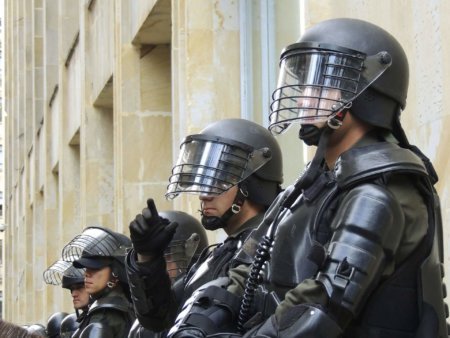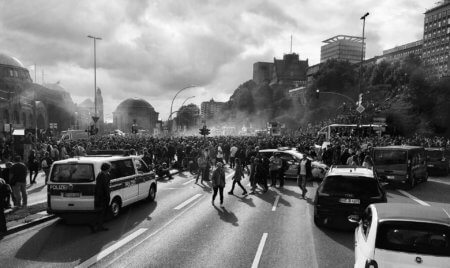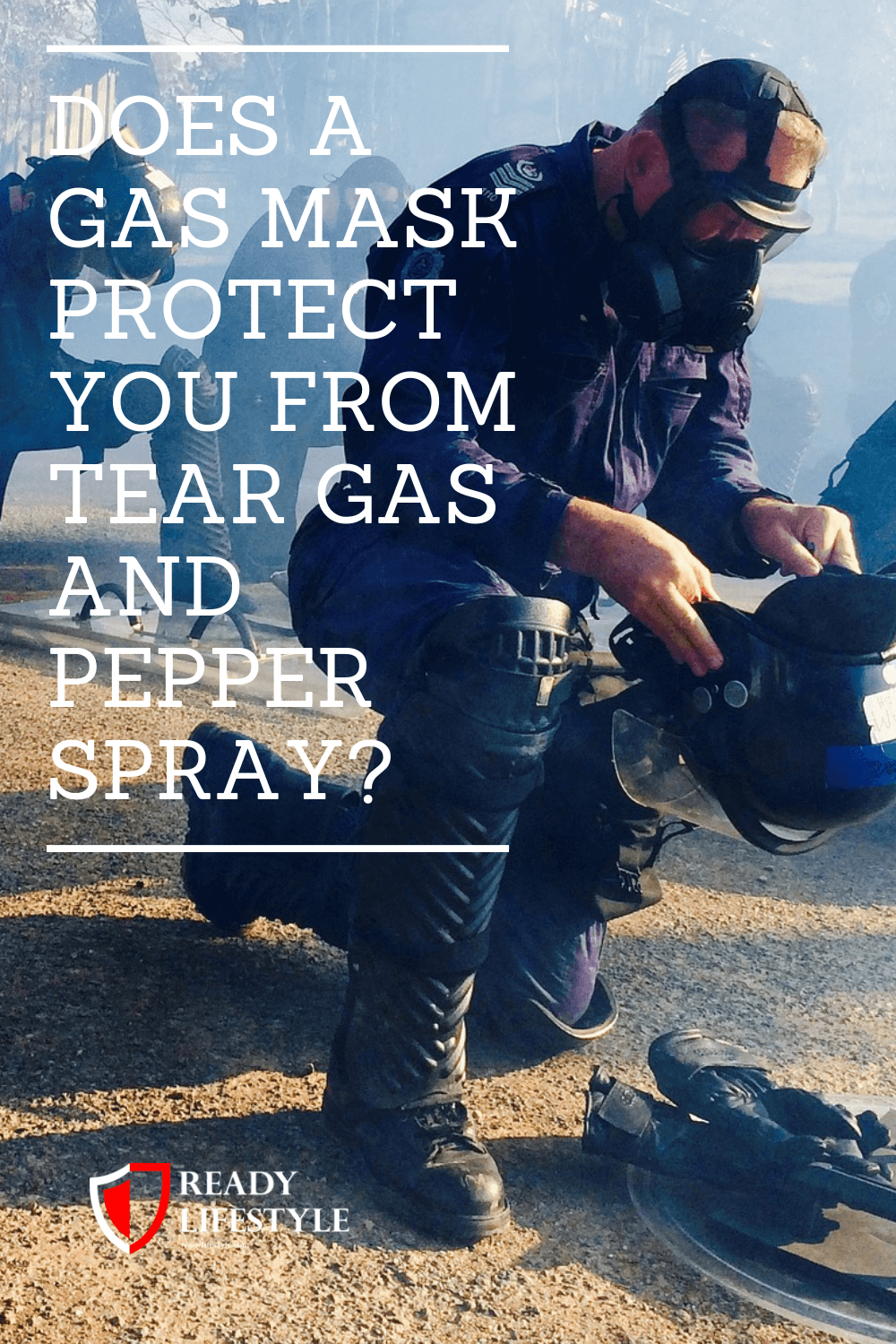Gas Mask vs. Tear Gas
Social unrest is on the rise across the world. Riots are becoming an almost common occurrence in certain cities. These riots are often broken up by police using tear gas.
Does a Gas Mask protect you from tear gas? A gas mask protects your eyes and lungs from tear gas. Most tear gas agents start as a solid and are made into an airborne particulate by burning. The particulates in the smoke are filtered out by the gas mask's filter.
If you happen to live near a larger city, you could get caught up in one of these riots. How can you defend yourself if you happen to be near the police when they use tear gas?
[wc_toggle title="Table of Contents" padding="" border_width="" class="" layout="box"]
- Gas Mask vs. Tear Gas
- How a Gas Mask Protects You From Tear Gas and Pepper Spray
- Does a Gas Mask Protect You From Pepper Spray?
- The Difference Between Tear Gas and Pepper Spray
- What Does Tear Gas Feel Like?
- How Long Does it Take for Tear Gas to Wear Off?
- Safe Tear Gas
- How to Stop the Effects of Tear Gas
- What Does Pepper Spray Feel Like?
- How Long Does it Take for Pepper Spray to Wear Off?
- How to Stop the Effects of Pepper Spray
- Related Questions
[/wc_toggle]
How a Gas Mask Protects You From Tear Gas and Pepper Spray
Gas masks are designed to protect the wearer from most chemical and biological agents. In this case, the gas mask is able to filter the tear gas particles from the air as the wearer inhales.
Most gas masks use chemically treated activated carbon (typically called activated charcoal). This activated carbon is designed to have an incredible amount of surface area which traps the tear gas particle in the gas mask filter in a process known as adsorption.

Does a Gas Mask Protect You From Pepper Spray?
A gas mask protects you from pepper stray in much the same way that it protects you from tear gas. The wearer of the gas mask has the active ingredients of the pepper stray filtered out of the air they're breathing before it reaches their lungs.
The mask also provides a physical barrier between the pepper spray and the wearer's face.
The Difference Between Tear Gas and Pepper Spray
Both pepper spray and tear gas are considered riot control agents but that's really where the similarities end.
Pepper spray is usually dispensed from a handheld can that sprays a stream of liquid irritant at the target. The active ingredient in pepper spray is capsaicin which comes from extremely hot members of certain peppers.
Pepper spray is usually used as a way for police to escalate their level of force without causing any long term harm to a person. It's also commonly used as a self-defense weapon among civilians that cannot or prefer not to carry firearms.
Tear gas is a better riot control agent as a whole. It's more of a military-grade agent meant to quickly disperse large mobs of people without having to resort to deadly weapons.
Tear gas is usually found in a grenade form and either thrown or fired from a grenade launcher. The active agent is usually CS or CN.
CS is the main form of tear gas used. CN is the active ingredient in mace as well as tear gas grenades but it's mostly being phased out as pepper stray and CS are more effective and CN is much more toxic than either of them.

What Does Tear Gas Feel Like?
Anyone who has been in the military probably can tell you from personal experience just what tear gas feels like.
Initially, the burning in your eyes isn't all that bad but the gas takes your breath away almost immediately. Very shortly after that, it hits your eyes and nose.
Once you've been completely affected by the tear gas, it's almost impossible to effectively fight (or do anything for that matter). Between choking, uncontrolled mucus filling your nose and your eyes completely closing shut, the only thing you can really do is retreat from the area and wait until you recover.
How Long Does it Take for Tear Gas to Wear Off?
Tear gas can take a while to wear off. Normally it doesn't last for any more than 30 minutes, but if you happen to touch your eyes or nose before being able to completely clean your hands and let your clothes air out, you can start up a less severe reaction all over again.
Some sources say that the effects can last for a few hours but I personally have never had a reaction that lasted that long. If you stay in the area you can expect to have the effects last longer. Those who have compromised respiratory systems can also have very severe reactions.
Safe Tear Gas
There isn't any such thing as completely safe tear gas. When you're dealing with any kind of riot control devices you're always walking a fine line between them being overly dangerous to the crowds you're trying to disperse and not being effective enough to actually do their jobs.
In the case of tear gas, it's actually pretty safe. Most healthy adults are simply forced out of the area and recover relatively quickly. It can be more dangerous for those that have health problems.

How to Stop the Effects of Tear Gas
The only way to prevent tear gas from affecting you is by wearing a gas mask. Some people will try to cover their faces with a rag soaked in water or some other liquids. This really doesn't work. You still get tear gas in your eyes and it gets into your lungs and nose just about as fast.
If you do happen to get stuck in a cloud of tear gas you should leave as soon as possible. Close your eyes if you can and try not to breathe as you get away from the area full of gas.
Once you get away from the tear gas, keep your hands away from your face, and find a water faucet to rinse your eyes.
The longer you rinse your eyes the more of the agent you'll remove. Keep blowing your nose as much as possible too. This will remove the agent from your sinuses.
The best tip is to try to remain calm. The effects are really intense and it can feel like you're not able to breathe but if you stay calm you're less likely to make it worse.
If you already can't breathe, running around or panicking is only going to make that feeling even worse. Keep telling your self that it'll get better (because it will) and it's not going to kill you.
What Does Pepper Spray Feel Like?
Pepper spray has an effect that is similar to CS gas. The eyes try to close, your sinuses begin to fill with mucus and drain down your face and breathing is difficult.
How Long Does it Take for Pepper Spray to Wear Off?
After getting hit by pepper stray it normally takes 20-30 minutes for them to wear off. If you get sprayed directly in the eyes, you can be left with red irritated eyes for up to 24 hours.
How to Stop the Effects of Pepper Spray
The only way that I know to start removing the effects of pepper stray is by putting your face in a mixture of dish soap and water. This breaks down the oils in the spray and can get rid of them sooner.
Some people say that spraying your face with cold whole milk can work or putting vegetable oil on your face for ten-minute intervals, cleaning it off with soap and water in between. I haven't tried either of these methods but they're said to work...
Related Questions
Has anyone ever died because of tear gas? There have deaths due to exposure to tear gas. They're very rare but they have happened. If you have any respiratory diseases, like asthma, you're at a much higher risk of dying after being exposed to tear gas.
Has anyone ever died because of pepper spray? Pepper spray has connected to quite a few deaths. Between 1990 and 1995, there were 61 deaths in America in cases where police used pepper spray on suspects.
Does a Gas Mask Protect You Against Tear Gas (and Pepper Spray) is available on: Ready Lifestyle Prepping Blog

Comments
Post a Comment